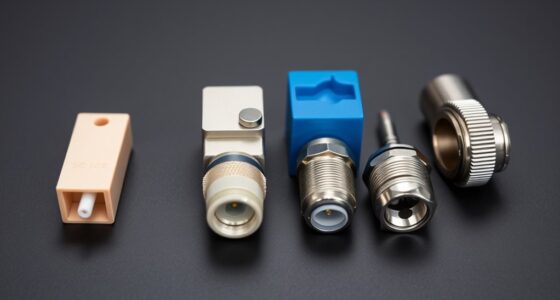As someone involved in network security, you understand the importance of protecting data transmitted over fiber optics. Modern approaches combine advanced encryption methods like Quantum Key Distribution with continuous monitoring tools to detect and prevent threats. But how effective are these layered defenses against evolving cyberattacks? Exploring how these technologies work together reveals the future of secure fiber networks—and what it takes to stay ahead.
Key Takeaways
- Quantum Key Distribution ensures secure data encryption by detecting eavesdropping in fiber networks.
- Combining encryption with real-time intrusion detection enhances overall network security.
- Machine learning tools analyze traffic patterns to identify and respond to evolving threats proactively.
- Layered security strategies integrate quantum encryption with monitoring systems for comprehensive protection.
- Continuous threat monitoring and advanced analysis safeguard fiber networks against both external and internal attacks.

Have you ever wondered how secure your data is when transmitted over fiber networks? Fiber optics are renowned for their speed and capacity, but security remains a critical concern. To protect sensitive information, modern fiber networks employ advanced encryption techniques, including the use of quantum keys. Unlike traditional cryptographic keys, quantum keys leverage the principles of quantum mechanics to generate secure encryption keys that are virtually impossible to intercept or replicate without detection. This process, known as quantum key distribution (QKD), ensures that any attempt to eavesdrop on the key exchange immediately alters the quantum states, alerting you to potential breaches. By integrating quantum key technology, network providers can markedly enhance the confidentiality of data transmitted across fiber links, making unauthorized access exceedingly difficult.
Quantum key distribution ensures unbreakable encryption and immediate breach detection in fiber optic networks.
However, encryption alone isn’t enough to fully secure a fiber network. You also need robust intrusion detection systems (IDS) to monitor for suspicious activities in real time. Intrusion detection involves scrutinizing network traffic for signs of malicious behavior, such as unauthorized access attempts, unusual data flows, or known attack signatures. When combined with quantum key encryption, intrusion detection provides a layered defense, giving you an extra line of defense against threats. For example, cyber threat landscape insights can help adapt security measures to emerging risks. If an attacker tries to intercept data while the quantum keys are being exchanged, the IDS can identify anomalies in network traffic patterns or unexpected disruptions, triggering alerts or automatic responses to block the attack. This proactive approach minimizes the risk of data breaches and helps you maintain the integrity of your fiber network.
Implementing effective intrusion detection requires continuous monitoring and sophisticated analysis tools. Modern IDS solutions use machine learning algorithms to adapt to evolving threats, recognizing new attack patterns even before they cause damage. These tools can analyze traffic in real time, detecting subtle indicators of intrusion that might otherwise go unnoticed. When paired with quantum key encryption, intrusion detection becomes more than just a reactive measure; it transforms into a proactive security strategy. You can set up alerts that notify you immediately of any suspicious activity, allowing you to respond swiftly and mitigate potential damage. Together, quantum key distribution and intrusion detection create a resilient security framework that safeguards your fiber network from both external and internal threats.
In essence, securing fiber networks isn’t just about deploying encryption; it’s about creating a detailed security ecosystem. Quantum keys provide unbreakable encryption, while intrusion detection offers real-time monitoring for threats. By combining these technologies, you can protect your data with confidence, knowing that your fiber network is equipped to detect and prevent malicious activities before they compromise sensitive information. This layered approach is essential in today’s digital landscape, where cyber threats continually evolve, and the stakes are higher than ever.
Frequently Asked Questions
How Do Encryption Methods Differ Between Fiber and Wireless Networks?
You’ll find that fiber encryption often uses robust end-to-end encryption protocols, providing high security for data traveling through physical cables. In contrast, wireless security relies on encryption methods like WPA3, which protect data over radio signals from eavesdropping. While fiber encryption emphasizes protecting data at rest and in transit within physical networks, wireless security focuses on safeguarding wireless signals from interception, ensuring both methods keep your information secure.
What Are the Latest Innovations in Fiber Network Intrusion Detection?
You should explore the latest innovations like quantum encryption and AI anomaly detection. Quantum encryption offers unprecedented security by leveraging quantum mechanics to detect eavesdropping, while AI anomaly detection continuously monitors network traffic for unusual activity. These advancements help you identify intrusions faster and more accurately, ensuring your fiber network stays protected against evolving threats. Embracing these technologies can profoundly enhance your network’s security posture.
How Often Should Fiber Network Security Protocols Be Updated?
You should update your fiber network security protocols at least quarterly, ensuring they stay ahead of emerging threats. Regular security audits are essential to identify vulnerabilities and verify the effectiveness of current measures. Incorporate protocol updates promptly after audit findings and industry best practices. Staying proactive with these updates helps protect your network from potential intrusions, maintaining the integrity and confidentiality of your data.
Can Fiber Network Monitoring Prevent All Cyber Threats?
You might think fiber network monitoring can prevent every cyber threat, but it’s like trying to catch every grain of sand—impossible! While monitoring drastically reduces risks, fiber optic vulnerabilities still exist, and limitations mean some threats can slip through. You stay protected best by combining monitoring with strong encryption and regular updates. Don’t rely solely on monitoring; it’s a powerful tool, but not a magic shield against all cyber threats.
What Are the Costs Associated With Implementing Advanced Fiber Security Measures?
Implementing advanced fiber security measures involves costs like hardware upgrades, encryption tools, and monitoring systems. You should conduct a thorough cost analysis to understand expenses and guarantee they fit within your budget planning. While initial investments might seem high, the long-term benefits of enhanced security, reduced data breaches, and compliance often outweigh these costs. Proper planning helps you allocate resources effectively, safeguarding your network without overspending.
Conclusion
By now, you see that securing fiber networks isn’t just about technology — it’s about staying one step ahead. Combining quantum encryption with continuous monitoring creates a robust shield against threats. Machine learning adds an extra layer of defense, making your network smarter and more resilient. Remember, “An ounce of prevention is worth a pound of cure.” Stay proactive, and your data will stay safe in this ever-evolving digital landscape.








